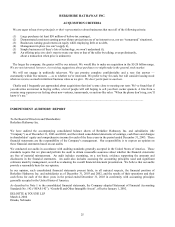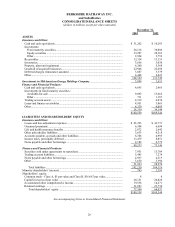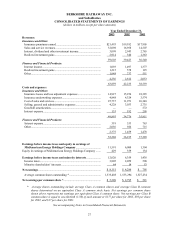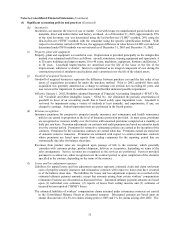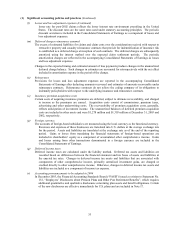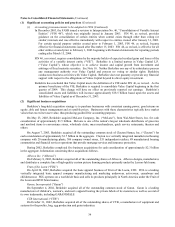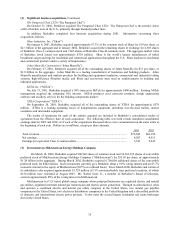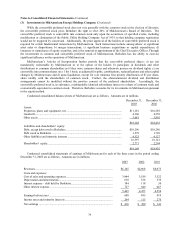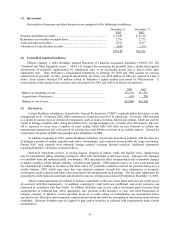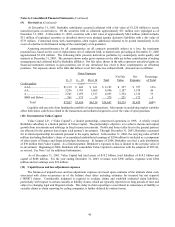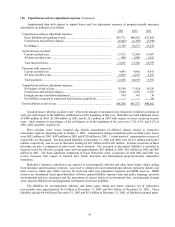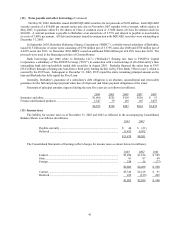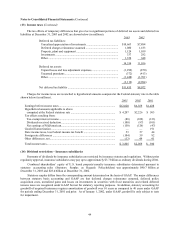Berkshire Hathaway 2003 Annual Report Download - page 35
Download and view the complete annual report
Please find page 35 of the 2003 Berkshire Hathaway annual report below. You can navigate through the pages in the report by either clicking on the pages listed below, or by using the keyword search tool below to find specific information within the annual report.34
Notes to Consolidated Financial Statements (Continued)
(1) Significant accounting policies and practices (Continued)
(r) Accounting pronouncements to be adopted in 2004 (Continued)
In December 2003, the FASB issued a revision to Interpretation No. 46, “Consolidation of Variable Interest
Entities” (“FIN 46”), which was originally issued in January 2003. FIN 46, as revised, provides
guidance on the consolidation of certain entities when control exists through other than voting (or
similar) interests and was effective immediately with respect to entities created after January 31, 2003.
For certain special purpose entities created prior to February 1, 2003, FIN 46, as revised, became
effective for financial statements issued after December 15, 2003. FIN 46, as revised, is effective for all
other entities created prior to February 1, 2003 beginning with financial statements for reporting periods
ending after March 15, 2004.
FIN 46, as revised, requires consolidation by the majority holder of expected residual gains and losses of the
activities of a variable interest entity (“VIE”). Berkshire is a limited partner in Value Capital L.P.
(“Value Capital”), whose objective is to achieve income and capital growth from investment and
arbitrage of fixed maturity securities. See Note 10. Neither Berkshire nor any of its subsidiaries possess
any management authority over Value Capital and possess no voting or similar rights. Berkshire
conducts no business activities with Value Capital. Berkshire does not guaranty or provide any financial
support with respect to the obligations of Value Capital beyond its direct equity investment.
Berkshire has concluded that Value Capital meets the definition of a VIE under FIN 46, as revised. As the
primary beneficiary of the VIE, Berkshire is required to consolidate Value Capital beginning in the first
quarter of 2004. This change will have no effect on previously reported net earnings. Berkshire’ s
consolidated assets and liabilities will increase approximately $18.5 billion based upon the assets and
liabilities of Value Capital as of December 31, 2003.
(2) Significant business acquisitions
Berkshire’ s long-held acquisition strategy is to purchase businesses with consistent earning power, good returns on
equity, able and honest management and at sensible prices. Businesses with these characteristics typically have market
values that exceed net asset value, thus producing goodwill for accounting purposes.
On May 23, 2003, Berkshire acquired McLane Company, Inc. (“McLane”), from Wal-Mart Stores, Inc. for cash
consideration of approximately $1.5 billion. McLane is one of the nation’ s largest wholesale distributors of groceries
and nonfood items to convenience stores, wholesale clubs, mass merchandisers, quick service restaurants, theaters and
others.
On August 7, 2003, Berkshire acquired all the outstanding common stock of Clayton Homes, Inc. (“Clayton”) for
cash consideration of approximately $1.7 billion in the aggregate. Clayton is a vertically integrated manufactured housing
company with 20 manufacturing plants, 306 company owned stores, 535 independent retailers, 89 manufactured housing
communities and financial services operations that provide mortgage services and insurance protection.
During 2002, Berkshire completed five business acquisitions for cash consideration of approximately $2.3 billion
in the aggregate. Information concerning these acquisitions follows.
Albecca Inc. (“Albecca”)
On February 8, 2002, Berkshire acquired all of the outstanding shares of Albecca. Albecca designs, manufactures
and distributes a complete line of high-quality custom picture framing products primarily under the Larson-Juhl name.
Fruit of the Loom (“FOL”)
On April 30, 2002, Berkshire acquired the basic apparel business of Fruit of the Loom, LTD. FOL is a leading
vertically integrated basic apparel company manufacturing and marketing underwear, activewear, casualwear and
childrenswear. FOL operates on a worldwide basis and sells its products principally in North America under the Fruit of
the Loom and BVD brand names.
Garan, Incorporated (“Garan”)
On September 4, 2002, Berkshire acquired all of the outstanding common stock of Garan. Garan is a leading
manufacturer of children’ s, women’ s, and men’ s apparel bearing the private labels of its customers as well as several of
its own trademarks, including GARANIMALS.
CTB International (“CTB”)
On October 31, 2002, Berkshire acquired all of the outstanding shares of CTB, a manufacturer of equipment and
systems for the poultry, hog, egg production and grain industries.



